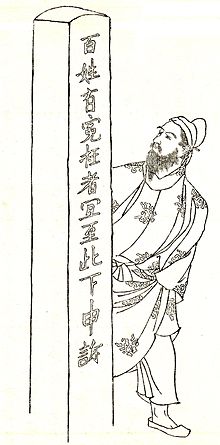


The Japanese missions to Tang China (遣唐使, kentōshi) were Japanese efforts to learn Chinese culture and civilization from Tang China, in the 7th, 8th and 9th centuries. The nature of those contacts evolved gradually from political and ceremonial change into cultural exchanges, and the process accompanied growing commercial ties which developed over time.[1]
From 607 to 838, Japan sent 19 missions to China. For each expedition, knowledge and learning were the principal objectives. Priests from Japan studied Chinese Buddhism, officials from Japan studied Chinese government, doctors from Japan studied Chinese medicine, and painters from Japan studied Chinese painting. Approximately one third of those who embarked from Japan did not survive to return home.[2]
| Year | Sender | Japanese envoys | Chinese monarch | Comments |
|---|---|---|---|---|
| 630-632 | Jomei | Inugami no Mitasuki (犬上御田鍬) Kusushi Enichi (藥師惠日) |
Taizong | Accompanied on return by Tang emissary Gao Biaoren (高表仁) |
| 653-654 | Kotoku | Kishi no Nagani (吉士長丹) Kishi no Koma (吉士駒) Takada no Nemaro (高田根麻呂) Kanimori no Omaro (掃守小麻呂) |
Gaozong | Vessel carrying Takada no Nemaro foundered on outward journey near the island of TakeshimainSatsuma Province |
| 654-655 | Kōtoku | Takamuko no Kuromaro[3] Kawabe no Maro (河邊) Kusushi Enichi |
Gaozong | Takamuko died in China[3] |
| 659-661 | Saimei | Sakaibe no Iwashiki (坂合部石布) Tsumori no Kisa (津守吉祥) Iki no Hakatoko (伊吉博德)[4] |
Gaozong | Sakaibe died during the trip |
| 665-667 | Tenji | Mori no Ōishi (守大石) Sakaibe no Iwatsumi (坂合部岩積) |
Gaozong | May have transported Tang emissary Liu Degao (劉德高) to army stationed at old Paekche garrison |
| 667-668 | Tenji | Iki no Hakatoko Kasa no Moroishi (笠諸石) |
Gaozong | Transported Tang emissary Sima Facong (司馬法聰) to army stationed at old Paekche garrison |
| 669-670 | Tenji | Kawachi no Kujira (河内鯨) | Gaozong | Celebrated subjugation of Koguryŏ |
| 702-704 | Mommu | Awata no Mahito (粟田真人) Takahashi no Kasama (高橋笠間) Sakaibe no Ōkita (坂合部大分) Yamanoue no Okura (山上憶良) Kose no Ōji (巨勢祖父) |
Wu Zetian | Kose no Ōji returned home in 707; Awata no Mahito returned in 718 |
| 717-718 | Genshō | Tajihi no Agatamori (多治比縣守) Abe no Yasumaro (阿倍安麻呂) Ōtomo no Yamamori (大伴山守) Fujiwara no Umakai (藤原馬養) |
Xuanzong | Awata no Mahito returned in 718; students Abe no Nakamaro and Kibi no Makibi as well as monk Genbō (玄昉) joined this embassy[5] |
| 733-734 | Shōmu | Tajihi no Hironari (多治比廣成) Nakatomi no Nashiro (中臣名代) |
Xuanzong | 4 ships set out on this voyage, and one ship returned in 734; another ship returned in 736; Magistrate Heguri no Hironari (平群廣成) returned in 739 |
| 746- | Shōmu | Isonokami no Otomaro (石上乙麻呂) | Xuanzong | cancelled |
| 750-753 | Kōken[6] | Fujiwara no Kiyokawa (藤原清河) Ōtomo no Komaro (大伴古麻呂) Kibi no Makibi (吉備真備) |
Xuanzong | Ship carrying Fujiwara no Kiyokawa and Abe no Nakamaro shipwrecked in Annam; both became Tang officials and never returned home |
| 761-761 | Junnin | Kō Gendo (高元度) | Suzong | With aim of retrieving Kiyokawa, traveled with Balhae ambassador returning home via Balhae; returned home with send-off by Tang emissary Shen Weiyue (沈惟岳) |
| 761- | Junnin | Naka no Iwatomo (仲石伴) Isonokami no Yakatsugu (石上宅嗣) Fujiwara no Tamaro (藤原田麻呂) |
Suzong | cancelled due to damage to vessels |
| 762- | Junnin | Nakatomi no Takanushi (中臣鷹主) Koma no Hiroyama (高麗廣山) |
Daizong | Cancelled due to lack of favorable wind |
| 777-778 | Kōnin | Saeki no Imaemishi (佐伯今毛人) Ōtomo no Masutate (大伴益立) Fujiwara no Takatori (藤原鷹取) Ono no Iwane (小野石根) Ōmiwa no Suetari (大神末足) |
Daizong | All four vessels shipwrecked en route home; Ono no Iwane and Tang emissary Zhao Baoying (趙寶英) died |
| 779-781 | Kōnin | Fuse no Kiyonao (布勢清直) | Dezong | Tang emissary Sun Xingjin 孫興進 et al. sent off at Mingzhou |
| 804-805 | Kammu | Fujiwara no Kadonomaro (藤原葛野麻呂) Ishikawa no Michimasu (石川道益) |
Dezong | 4 ships on this mission; vessel 3 shipwrecked at Hirado on the outward journey; news of vessel 4 unknown; Kūkai and Saichō joined this embassy |
| 838-839 | Ninmyō | Fujiwara no Tsunetsugu (藤原常嗣) Ono no Takamura (小野篂) |
Wenzong | Vessel 3 shipwrecked soon after departure at Tsukushi; its 140 passengers did not reach China; the monks Ennin and Ensai on board; passengers on vessels 1 and 4 hired Silla vessels and split up for the voyage home; returning in 839 with a letter from Chinese emperor;[7] vessel 2 returned home in 840 |
| 894- | Uda | Sugawara no Michizane (菅原道真) Ki no Haseo (紀長谷雄) |
Zhaozong | cancelled |

| Authority control databases: National |
|
|---|